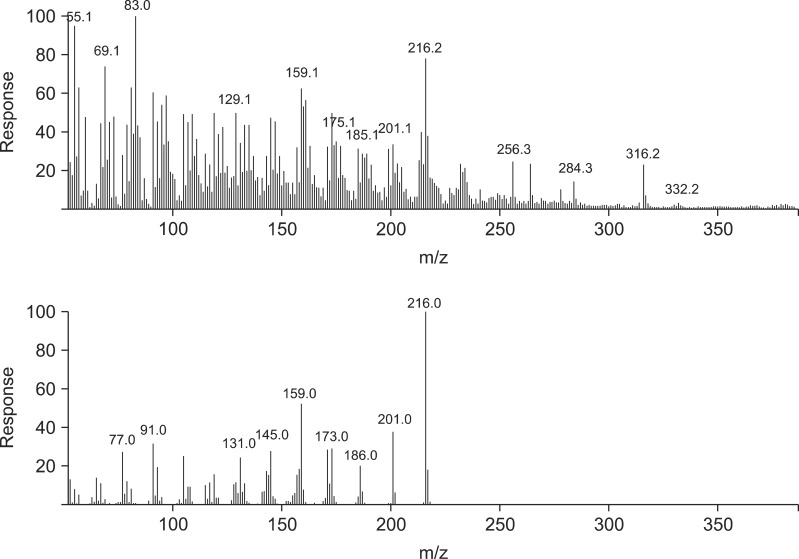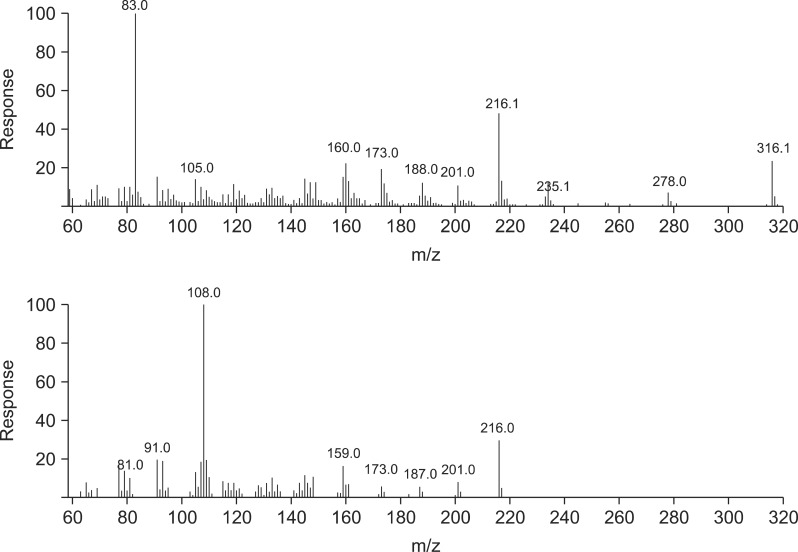J Vet Sci.
2013 Sep;14(3):241-248. 10.4142/jvs.2013.14.3.241.
GC/MS analysis of high-performance liquid chromatography fractions from Sophora flavescens and Torilis japonica extracts and their in vitro anti-neosporal effects on Neospora caninum
- Affiliations
-
- 1Pfizer Animal Health, Seoul 135-784, Korea.
- 2College of Veterinary Medicine, Seoul National University, Seoul 151-742, Korea. younhj@snu.ac.kr
- 3College of Veterinary Medicine, Jeju National University, Jeju 690-756, Korea.
- KMID: 1705553
- DOI: http://doi.org/10.4142/jvs.2013.14.3.241
Abstract
- We analyzed alcoholic extracts of herbs possessing anti-neosporal activity against Neospora (N.) caninum. To identify the chemical components of Sophora (S.) flavescens and Torilis (T.) japonica associated with anti-neosporal activity, specific fractions were isolated by high-performance liquid chromatography (HPLC). In vitro activity of the fractions against N. caninum was then assessed. Gas chromatography/mass spectrometry (GC/MS) was used to identify and quantify specific anti-neosporal molecules in the herbal extracts. Almost all HPLC fractions of S. flavescens and T. japonica had higher levels of anti-neosporal activity compared to the not treated control. Active constituents of the extracts were sophoridane, furosardonin A, and tetraisopropylidene-cyclobutane in S. flavescens; 5,17-beta-dihydroxy-de-A-estra-5,7,9,14-tetraene, furanodiene, and 9,12-octadecadienoic acid (Z,Z)-(CAS,1) in T. japonica.
Keyword
MeSH Terms
Figure
Reference
-
1. Ammann P, Waldvogel A, Breyer I, Esposito M, Müller N, Gottstein B. The role of B- and T-cell immunity in toltrazuril-treated C57BL/6 WT, µMT and nude mice experimentally infected with Neospora caninum. Parasitol Res. 2004; 93:178–187. PMID: 15290254.
Article2. Andina D, Bernardi MD, Del Vecchio A, Fronza G, Mellerio G, Vidari G, Vita-Finzi P. Sequiterpenes from Russula sardonia. Phytochemistry. 1980; 19:93–97.3. Behrendt JH, Taubert A, Zahner H, Hermosilla C. Studies on synchronous egress of coccidian parasites (Neospora caninum, Toxoplasma gondii, Eimeria bovis) from bovine endothelial host cells mediated by calcium ionophore A23187. Vet Res Commun. 2008; 32:325–332. PMID: 18158611.4. Cho WI, Choi JB, Lee K, Chung MS, Pyun YR. Antimicrobial activity of torilin isolated from Torilis japonica fruit against Bacillus subtilis. J Food Sci. 2008; 73:M37–M46. PMID: 18298734.5. Darius AK, Mehlhorn H, Heydorn AO. Effects of toltrazuril and ponazuril on Hammondia heydorni (syn. Neospora caninum) infections in mice. Parasitol Res. 2004; 92:520–522. PMID: 14963771.6. Darkin-Rattray SJ, Gurnett AM, Myers RW, Dulski PM, Crumley TM, Allocco JJ, Cannova C, Meinke PT, Colletti SL, Bednarek MA, Singh SB, Goetz MA, Dombrowski AW, Polishook JD, Schmatz DM. Apicidin: a novel antiprotozoal agent that inhibits parasite histone deacetylase. Proc Natl Acad Sci U S A. 1996; 93:13143–13147. PMID: 8917558.
Article7. Dirikolu L, Yohn R, Garrett EF, Chakkath T, Ferguson DC. Detection, quantifications and pharmacokinetics of toltrazuril sulfone (Ponazuril) in cattle. J Vet Pharmacol Ther. 2009; 32:280–288. PMID: 19646093.
Article8. Fuchs N, Ingold K, Sonda S, Bütikofer P, Hemphill A. Detection of surface-associated and intracellular glycoconjugates and glycoproteins in Neospora caninum tachyzoites. Int J Parasitol. 1999; 29:1597–1611. PMID: 10608447.9. Fujita S. Miscellaneous contributions to the essential oils of plants from various territories. LI. On the components of essential oils of Torilis japonica (Houtt.) DC. Yakugaku Zasshi. 1990; 110:771–775. PMID: 2074533.10. Gargala G, Baishanbo A, Favennec L, François A, Ballet JJ, Rossignol JF. Inhibitory activities of epidermal growth factor receptor tyrosine kinase-targeted dihydroxyisoflavone and trihydroxydeoxybenzoin derivatives on Sarcocystis neurona, Neospora caninum, and Cryptosporidium parvum development. Antimicrob Agents Chemother. 2005; 49:4628–4634. PMID: 16251305.11. Gottstein B, Eperon S, Dai WJ, Cannas A, Hemphill A, Greif G. Efficacy of toltrazuril and ponazuril against experimental Neospora caninum infection in mice. Parasitol Res. 2001; 87:43–48. PMID: 11199848.12. Gottstein B, Razmi GR, Ammann P, Sager H, Müller N. Toltrazuril treatment to control diaplacental Neospora caninum transmission in experimentally infected pregnant mice. Parasitology. 2005; 130:41–48. PMID: 15700756.13. Haerdi C, Haessig M, Sager H, Greif G, Staubli D, Gottstein B. Humoral immune reaction of newborn calves congenitally infected with Neospora caninum and experimentally treated with toltrazuril. Parasitol Res. 2006; 99:534–540. PMID: 16628455.14. Hay WH, Shell LG, Lindsay DS, Dubey JP. Diagnosis and treatment of Neospora caninum infection in a dog. J Am Vet Med Assoc. 1990; 197:87–89. PMID: 2370226.15. Kim JH, Hwang EK, Sohn HJ, Jean YH, Yoon SS, Kim DY. Repeated bovine abortion associated with Neospora caninum in Korea. Korean J Vet Res. 1998; 38:853–858.16. Kim SE, Kim YH, Kim YC, Lee JJ. Torilin, a sequiterpene from Torilis japonica, reverses multidrug-resistance in cancer cells. Planta Med. 1998; 64:332–334. PMID: 9619115.17. Kitajima J, Suzuki N, Satoh M, Watanabe M. Sesquiterpenoids of Torilis japonica fruit. Phytochemistry. 2002; 59:811–815. PMID: 11937159.18. Kuroyanagi M, Arakawa T, Hirayama Y, Hayashi T. Antibacterial and antiandrogen flavonoids from Sophora flavescens. J Nat Prod. 1999; 62:1595–1599. PMID: 10654410.19. Lee IK, Lee JH, Hwang EI, Yun BS. New guaiane sesquiterpenes from the fruits of Torilis japonica. Chem Pharm Bull. 2008; 56:1483–1485. PMID: 18827397.20. Lindsay DS, Butler JM, Rippey NS, Blagburn BL. Demonstration of synergistic effects of sulfonamides and dihydrofolate reductase/thymidylate synthase inhibitors against Neospora caninum tachyzoites in cultured cells, and characterization of mutants resistant to pyrimethamine. Am J Vet Res. 1996; 57:68–72. PMID: 8720241.21. Lindsay DS, Dubey JP. Effects of sulfadiazine and amprolium on Neospora caninum (Protozoa: Apicomplexa) infections in mice. J Parasitol. 1990; 76:177–179. PMID: 2319416.22. Matsumura T, Kasai M, Hayashi T, Arisawa M, Momose Y, Arai I, Amagaya S, Komatsu Y. α-Glucosidase inhibitors from Paraguayan natural medicine, Ñangapiry, the leaves of Eugenia uniflora. Pharm Biol. 2000; 38:302–307. PMID: 21214481.23. Mitchell SM, Zajac AM, Davis WL, Kennedy TJ, Lindsay DS. The effects of ponazuril on development of apicomplexans in vitro. J Eukaryot Microbiol. 2005; 52:231–235. PMID: 15926999.
Article24. Ogunwande IA, Olawore NO, Ekundayo O, Walker TM, Schmidt JM, Setzer WN. Studies on essential oils composition, antibacterial and antitoxicity of Eugenia unifera L. Int J Aromatherapy. 2005; 15:147–152.25. Park SJ, Nam KW, Lee HJ, Cho EY, Koo U, Mar W. Neuroprotective effects of an alkaloid-free ethyl acetate extract from the root of Sophora flavescens Ait. against focal cerebral ischemia in rats. Phytomedicine. 2009; 16:1042–1051. PMID: 19427179.26. Piao XL, Piao XS, Kim SW, Park JH, Kim HY, Cai SQ. Identification and characterization of antioxidants from Sophora flavescens. Biol Pharm Bull. 2006; 29:1911–1915. PMID: 16946508.27. Strohbusch M, Müller N, Hemphill A, Greif G, Gottstein B. NcGRA2 as a molecular target to assess the parasiticidal activity of toltrazuril against Neospora caninum. Parasitology. 2008; 135:1065–1073. PMID: 18549517.28. Strohbusch M, Müller N, Hemphill A, Krebber R, Greif G, Gottstein B. Toltrazuril treatment of congenitally acquired Neospora caninum infection in newborn mice. Parasitol Res. 2009; 104:1335–1343. PMID: 19205743.29. Terada M, Sano M, Ishii AI, Kino H, Fukushima S, Noro T. Studies on chemotherapy of parasitic helminths (IV). Effects of alkaloids from Sophora flavescens on the motility of parasitic helminths and isolated host tissues (author's transl). Nihon Yakurigaku Zasshi. 1982; 79:105–111. (Japanese). PMID: 7200047.30. Yang FQ, Li SP, Chen Y, Lao SC, Wang YT, Dong TTX, Tsim KWK. Identification and quantitation of eleven sesquiterpenes in three species of Curcuma rhizomes by pressurized liquid extraction and gas chromatography-mass spectrometry. J Pharm Biomed Anal. 2005; 39:552–558. PMID: 15946818.31. Yang X, Baburin I, Plitzko I, Hering S, Hamburger M. HPLC-based activity profiling for GABAA receptor modulators from the traditional Chinese herbal drug Kushen (Sophora flavescens root). Mol Divers. 2011; 15:361–372. PMID: 21207144.32. Ye G, Zhu HY, Li ZX, Ma CH, Fan MS, Sun ZL, Huang CG. LC-MS characterization of efficacy substances in serum of experimental animals treated with Sophora flavescens extracts. Biomed Chromatogr. 2007; 21:655–660. PMID: 17370298.33. Youn HJ, Noh JW. Screening of the anticoccidial effects of herb extracts against Eimeria tenella. Vet Parasitol. 2001; 96:257–263. PMID: 11267752.34. Youn HJ, Lakritz J, Kim DY, Rottinghaus GE, Marsh AE. Anti-protozoal efficacy of medicinal herb extracts against Toxoplasma gondii and Neospora caninum. Vet Parasitol. 2003; 116:7–14. PMID: 14519322.35. Youn HJ, Lakritz J, Rottinghaus GE, Seo HS, Kim DY, Cho MH, Marsh AE. Anti-protozoa efficacy of high performance liquid chromatography fractions of Torilis japonica and Sophora flavescens extracts on Neospora caninum and Toxoplasma gondii. Vet Parasitol. 2004; 125:409–414. PMID: 15482896.
- Full Text Links
- Actions
-
Cited
- CITED
-
- Close
- Share
- Similar articles
-
- Sophora flavescens Extracts Have Therapeutic Effects on Overactive Bladder Syndrome by Potentiation of Large-Conductance Calcium-Activated Potassium Channel
- Anti-inflammatory and Anti-oxidant Effects of Sophora flavescens Root Extraction in Lipopolysaccharide-activated Raw 264.7 Cells
- Quantitative Analysis of Flavonoid Glycosides in Sophora japonica and Sophora flavescens by HPLC-DAD
- In vitro Effect of Sophora flavescens on the Ultrastructure of Trichomonas vaginalis Donne
- Protective efficacy of vaccination with Neospora caninum multiple recombinant antigens against experimental Neospora caninum infection







